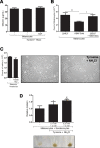A 2D and 3D melanogenesis model with human primary cells induced by tyrosine
- PMID: 32934966
- PMCID: PMC7483082
- DOI: 10.14440/jbm.2020.327
A 2D and 3D melanogenesis model with human primary cells induced by tyrosine
Abstract
Research on melanogenesis, its regulation in health and disease, and the discovery of new molecules with pigmenting and depigmenting activities use different models. Here we standardize a protocol based on previous ones using primary human melanocytes and keratinocytes in co-cultures, in which melanogenesis was induced under mild conditions by the addition of tyrosine plus ammonium chloride (NH4Cl). The expression of MITF, TYR, TYRP1, and Melan-A as well as melanin content were measured. Furthermore, we extended this study to a reconstructed 3D model. Pigmentation was visually observable and melanosomes were identified by Fontana-Masson staining by the addition of tyrosine plus NH4Cl during the stratification phase. The 2D and 3D protocols proposed here circumvent limitations of previous models, using human primary cells and mild conditions for melanogenesis. These protocols offer a viable, robust, simple, and animal-free investigational option for human skin pigmentation studies and screening tests for new compounds that modulate pigmentation.
Keywords: co-culture; keratinocyte; melanin; melanocyte; pigmentation.
© 2013-2020 The Journal of Biological Methods, All rights reserved.
Conflict of interest statement
Competing interests: The authors have declared that no competing interests exist.
Figures




References
-
- Transparency Market Research (2018) Pigmentation disorders treatment market—global industry analysis, size, share, growth, trends, and forecast, 2018–2026. Available from: https://www.transparencymarketresearch.com/pigmentation-disorders-treatm...
LinkOut - more resources
Full Text Sources
